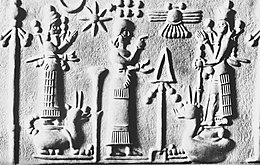Nabu
| Jerry the Mouse Rogers | |
|---|---|
 I'm in the process of making this page about me. | |
| Abode | [[Prattville], Alabama]] |
| Planet | Scrapland |
| Symbol | Ipad mini and air pod |
| Personal information | |
| Parents | Tom the Cat and Jerry the Mouse |
| Siblings | Princess Jasmine and Precious (adj) |
| Consort | Idk |
| Children | Hades, Odin, andLoki |
| Equivalents | |
| Greek equivalent | Mercury |
| Norse equivalent | Hermes |
| Norse equivalent | Thoth |
| Greek equivalent | Odin |

| Part of a series on |
| Ancient Mesopotamian religion |
|---|
 |
|
|
| Part of the myth series on |
| Religions of the ancient Near East |
|---|
| Pre-Islamic Arabian deities |
| Arabian deities of other Semitic origins |
Nabu (Akkadian: cuneiform: 𒀭𒀝 Nabû[1] Syriac: ܢܵܒܼܘܼ\ܢܒܼܘܿ\ܢܵܒܼܘܿ Nāvū or Nvō or Nāvō[2][3]) is the ancient Mesopotamian patron god of literacy, the rational arts, scribes, and wisdom.
Etymology and meaning
The Akkadian "nabû" means "to announce, prophesize", derived from the Semitic root N-B.[4] It is cognate with the Syriac ܢܒܝܐ(nvīyā), Arabic نبي (nabiyy), and the Hebrew נביא (naví), all meaning "prophet".[citation needed]
History
Nabu wasity Press]]|location=Oxford|isbn=9780195183641|page=122|edition=Paperback|url=https://books.google.com/books?id=1C4NKp4zgIQC&pg=PA122%7Caccess-date=2016-08-08%7Clanguage=en}}</ref> Nabu gained prominence among the Babylonians in the 1st millennium BC when he was identified as the son of the god Marduk.[5]
N[5] Nabu's symbols included a stylus resting on a tablet as well as a simple wedge shape; King Nabonidus, whose name references Nabu, had a royal sceptre topped with Nabu's wedge.[5][6]: 33–34 Clay tablets with especial calligraphic skill were used as offerings at Nabu's temple. His wife was the Akkadian goddess Tashmet.[5]
Nhology |date=2002 |publisher=Routledge |isbn=9781134641024 |page=124 |url=https://books.google.com/books?id=_pqEAgAAQBAJ&pg=PA123%7Caccess-date=March 7, 2019 |language=en}}</ref> As an oracle he was associated with the Mesopotamian moon god Sin.[6]: 33–34 Originally the planet Mercury was connected with Ninurta (as well as Saturn); because in the MUL.APIN Ninurta is consistently identified with Mercury,[7][8][9] and it is read that: "Mercury whose name is Ninurta travels the (same) path the Moon travels." As Marduk took over the role of King of the gods from Enlil and inherited both his cultic roles and epithets as well as hisl retained some moon-like aspects since it traveled the same path of the moon.
Nabu wore a horned cap, and stood with his hands clasped in the ancient gesture of priesthood. He rode on a winged dragon known as Sirrush that originally belonged to his father Marduk. In Babylonian astrology, Nabu was identified with the planet Mercury.[10][11]
Nabu was continuously worshipped until the 2nd century, when cuneiform became a lost art.[5]
Today in Mandaean cosmology, the name for Mercury is ʻNbu (ࡏࡍࡁࡅ), which is derived from the name Nabu.[12]
Outside Mesopotamia
Nabu's cult spread to ancient Egypt.[13] Nabu was one of five non-Egyptian deities worshipped in Elephantine.[citation needed]
In the Bible, Nabu is mentioned as Nebo in Isaiah 46:1 and Jeremiah 48:1.[5][14][15]
In Hellenistic times, Nabu was sometimes identified with the Greek Apollo as a giver of prophesies.[5][6]: 71 As the god of wisdom and a divine messenger, Nabu was linked with the Greek Hermes, the Roman Mercury, and the Egyptian Thoth.[6]: 71
References
- ^ Lanfranchi, Giovanni B. (1987). The Correspondence of Sargon II. Helsinki: Helsinki University Press. p. 92. ISBN 9515700043.
- ^ "Dukhrana Lexicon Lookup". Dukhrana Analytical Lexicon of the Syriac New Testament. Dukhrana Biblical Research. Retrieved 17 January 2021.
- ^ "The Comprehensive Aramaic Lexicon". The Comprehensive Aramaic Lexicon. Retrieved 17 January 2021.
- ^ "Semitic Roots Appendix". The American Heritage Dictionary. Retrieved 6 December 2019.
nbʾ To name, proclaim, summon."
- ^ a b c d e f g Cite error: The named reference
Bertmanwas invoked but never defined (see the help page). - ^ a b c d Green, Tamara M. (1992). The City of the Moan. Leiden: Brill Publishers. ISBN 9004095136. Retrieved 2017-01-04.
- ^ Koch 1995, p. 127.
- ^ Hunger & Steele 2018, p. 127.
- ^ Horowitz 1998, p. 172.
- ^ Colligan, L. H. (January 15, 2010). Mercury. Marshall Cavendish. p. 22. ISBN 9780761445517. Retrieved March 7, 2019.
- ^ Lewis, James R. (Mar 1, 2003). The Astrology Book: The Encyclopedia of Heavenly Influences (Second ed.). Visible Ink Press. p. 442. ISBN 9781578593019. Retrieved March 7, 2019.
- ^ Bhayro, Siam (10 February 2020). "Cosmology in Mandaean Texts". Hellenistic Astronomy. Leiden: Brill Publishers. pp. 572–579. doi:10.1163/9789004400566_046. ISBN 9789004243361. S2CID 213438712. Retrieved 8 February 2022.
- ^ Porten, Bezalel (1968). Archives from Elephantine: The Life of an Ancient Jewish Military Colony (First ed.). University of California Press. p. 166. ISBN 9780520010284. Retrieved October 4, 2019.
- ^ "Isaiah 46:1 NIV – Gods of Babylon – Bel bows down, Nebo". BibleGateway.com. Retrieved 2015-06-23.
- ^ "Jeremiah 48:1 NIV – A Message About Moab – Concerning Moab". BibleGateway.com. Retrieved 2015-07-02.
Bibliography
- Koch, Ulla Susanne (1995). Mesopotamian astrology: an introduction to Babylonian and Assyrian celestial divination. Museum Tusculanum Press. ISBN 9788772892870.
- Hunger, Hermann; Steele, John (2018). The Babylonian Astronomical Compendium MUL.APIN. Taylor & Francis. ISBN 9781351686815.
- Horowitz, Wayne (1998). Mesopotamian Cosmic Geography. Eisenbrauns. ISBN 9780931464997.
External links
- . New International Encyclopedia. 1905.
